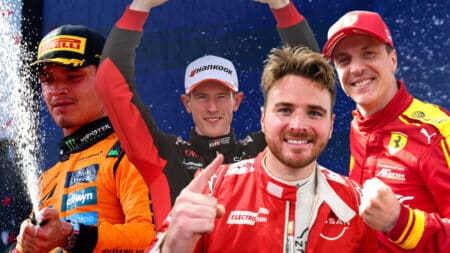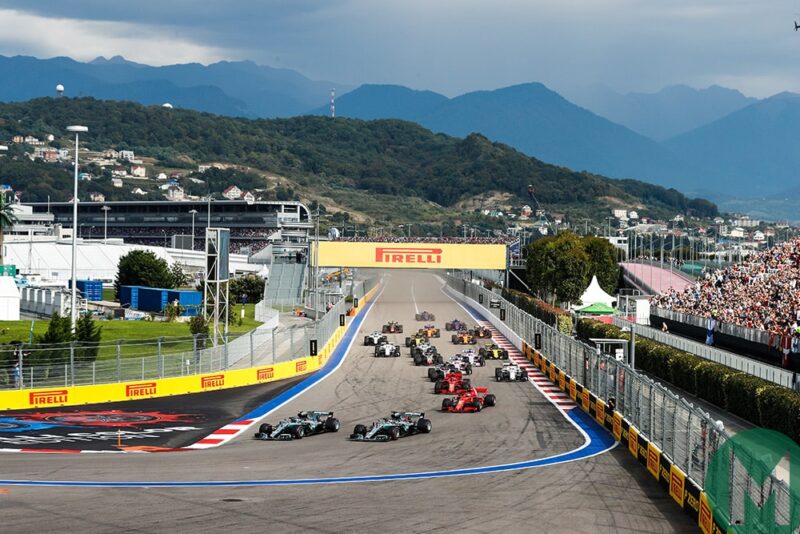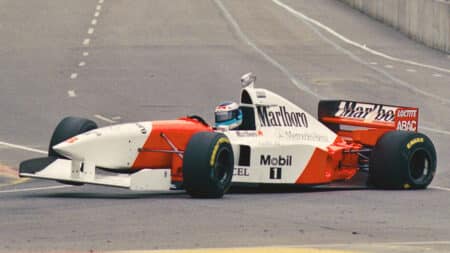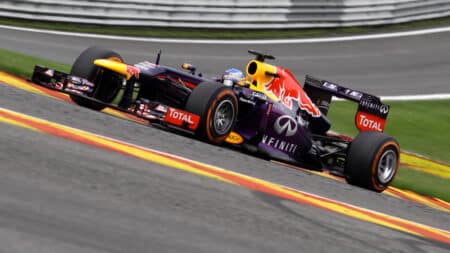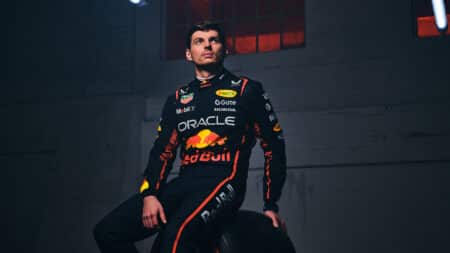By the time Vladimir Putin arrived and the accompanying array of binoculars and rifles appeared on the roofs, it was lap 41. He’d missed the crucial moment of the race’s outcome.
That had happened 28 laps earlier as Mercedes caught itself in a knot, making it harder than it should have been to score a 1-2 over Sebastian Vettel in a Ferrari that had struggled with the peculiar tyre demands of the Sochi track. The question of which Mercedes driver would take the victory ended up getting caught in that knot. The outcome of team order ambiguity was that Lewis Hamilton won from a sorely disappointed Valtteri Bottas who, after setting pole, had comfortably controlled the race right up until the decisive first stops.
At that moment, as the ultrasofts began to fade and with the necessary gap established over the midfield, Mercedes team boss Toto Wolff was in deep discussion with his chief strategist James Vowles. With Bottas having just been pitted from the lead and Vettel sure to follow suit next lap, the strategic logic of the situation (i.e. the Vowles responsibility) was for Hamilton (who was narrowly ahead of Vettel) to be brought in immediately. That way, they’d all rejoin in the same order, with Mercedes’ 1-2 still intact. But from the perspective of a team boss trying to secure a world title, was there opportunity here? What if they left Hamilton out, watched Vettel pit, then got Bottas to back him up while Lewis was given an extra lap in the lead to emerge ahead of them both through the overcut? So Wolff and Vowles were deep in discussion when otherwise Hamilton might be pitting.
“Guys, how did that just happen?” asked Hamilton, not unreasonably.
In the ambiguity created by Wolff’s conflict between his business brain and racing heart, a sequence of events was triggered that caused a bit of discomfort.
During this discussion they imagined they might have the luxury of this extra lap, because the pre-race estimate was that the undercut that Vettel was potentially going to enjoy was in the order of 0.9sec. It was double that, because the new soft got straight up to temperature. So, during this luxury lap they didn’t really have, the discussion continued. In the meantime, Bottas was instructed to reduce his pace and back Vettel up. “Yeah, Valtteri was backing me up,” confirmed Vettel post-race. But not enough for the plan to work.
Hamilton was ordered in next lap (two laps after Bottas, one later than Vettel). His in-lap was compromised a little towards the end as he caught the Williams of Sergey Sirotkin and, although the stop itself was good, it wasn’t good enough to overcome the combined effect of Vettel’s great out-lap and Hamilton’s compromised in-lap on old tyres. In all the scenarios that had been discussed at Mercedes that morning, it hadn’t included Bottas backing up Vettel, and by how much. Valtteri had every reason to believe that, having set pole, he’d be allowed to fight for the win. So Hamilton came out third, partly alongside – but behind – the Ferrari. “Guys, how did that just happen?” asked Hamilton, not unreasonably.
The answer to that had far too many complexities to be discussed over the radio. But the happy ending for Hamilton, after he fought back past Vettel wheel-to-wheel and was handed the lead by Bottas under team instruction, was an extension of his championship lead over Vettel to 50 points. The ending for Bottas was not quite so happy.
The Mercedes route to victory took up most of the attention but, as that convoluted story was playing out, there were two fabulous performances from Red Bull’s Max Verstappen (fifth from the back of the grid) and Charles Leclerc, who totally dominated ‘Class B’ for Sauber in seventh overall.
Qualifying
Was there a connection between the raft of updates on the Mercedes (twin rear wing pillar that probably allows a little more aero elasticity) and the Ferrari (new front wing with more extensive outwash vanes), and the loss of Ferrari’s competitiveness?
Something wasn’t quite right on the Ferrari, which wasn’t even quicker than a pair of Red Bulls that were never seriously trying to extract their maximum single lap pace, given that they were taking engine penalties.
Actually, those Red Bull penalties – known before the weekend even got underway – offered a clue. Once Ferrari saw on Friday morning that it could not balance the tyre temperatures through the three sectors, it added more rear wing – to keep the rears from overheating in sector three. It was more wing than ideal in terms of one-lap balance, but probably necessary. Furthermore, even with a balance compromise, the Red Bull penalties will have assured Ferrari it would be starting from row two at worst.
Combine that with a Mercedes with upgrades that were working very well regardless of Ferrari’s problems. In fact the traits of the two cars were almost transposed from last year, the Ferrari able to be quick in sectors one or three but not both; the Mercedes better able to balance the requirements between front and rear tyres to keep the rears from overheating – helped by its recent heat-dissipating concave brake drum on the rear wheels (from Singapore) and accompanying wheel rims (introduced at Spa). Give such a car to Valtteri Bottas – a driver who has never been out-qualified by a team-mate around here – and the pole was almost a formality. Just like last year, Hamilton had no answer to the Finn’s minimalist approach around the low-grip track between the walls. Bottas is stunningly good around this place, in turn aggressive and patient as required, driving around any of the car’s difficulties, not asking of it things it doesn’t have to give but extracting all that it does. Fastest on both Q3 runs, his margin over Hamilton was 0.145sec, with the latter abandoning his second run after getting out of shape in Turn Seven. That’s how good Bottas was on Saturday afternoon.
But the W08 was also working superbly, rotating progressively into the slow corners and getting both the ultrasoft (as used in Q2) and the hypersoft tyres working nicely. The hyper was making its first appearance at this track and as well as the usual challenge of judging how much to take from it in the first sector to still have it alive through the right-angled turns of sector three, care was also needed to keep graining of the left-front at bay. The Mercedes and the Red Bull seemed to be meeting this combined challenge better than the Ferrari.
But, with the Red Bulls only running in Q1, Ferrari locked out row two, Vettel around 0.5sec down on Bottas but 0.3sec in front of Kimi Räikkönen. “Some of that was a small mistake I made on the last lap as I was trying to find half a second,” said Vettel. “In reality, it was probably more like 0.2sec we lacked. But the car actually felt good, well balanced and it peaked in Q3, so it was a good programme.” He seemed curiously unconcerned.
Both of Räikkönen’s Q3 runs were compromised by being sent out on the tail of Hamilton’s Mercedes, a car that requires a slower preparation lap than the Ferrari. But maybe this time (unlike at Singapore) it was deliberate. That third-place grid slot (better than second or fourth) was potentially vital for Vettel’s race prospects, after all… Whatever, it meant Räikkönen began both laps understeering into the corner onto the straight, then snap-oversteering out as a result of under-temperature front tyres. He couldn’t improve during his second run. Like Mercedes, Ferrari got both cars through Q2 on the harder, ultrasoft, tyres which were around 0.7sec slower than the hypersofts but a lot more durable.
With a place on the third row up for grabs, but a Singapore-like situation where it was going to be bad news on race day to be at the tail-end of Q3, it was tricky to gauge what the correct approach was for the usual ‘best of rest’ contenders. Which of those made it through to Q3 wasn’t even a run-off on this occasion, however – as only 10 cars ran in Q2! The two Red Bulls stayed in their garages on account of the engine penalties that would put them at the back regardless. This was true also of Pierre Gasly’s Toro Rosso. Honda had introduced a new evolution of its power unit and wanted to try it here in preparation for Suzuka. It gave a very useful power boost when both cars ran it on Friday and put the car smack on the pace of Force India as ‘best of the rest’ but this engine was taken back out for the rest of the weekend to perfect some programming details (and to limit the mileage). Both Gasly and Brendon Hartley (who didn’t run a serious Q1 lap) would therefore be starting from the back. Which meant that Renault, with a car that, despite its new floor, wasn’t as competitive as usual, knew it would be starting 11th and 12th (Carlos Sainz marginally faster than Nico Hülkenberg in Q1) – with free tyre choice if it just stayed put and didn’t run Q2 at all.
Hence, in addition to Mercedes and Ferrari, only Haas, Force India and Sauber ran in Q2 – 10 cars, all of which were therefore guaranteed a place in Q3. Once there, it was Kevin Magnussen’s Haas that strung the best lap together to take that coveted place on the inside of row three, after Esteban Ocon got just a little out of shape and only just stayed ahead of Leclerc’s Sauber. This left Sergio Pérez, Romain Grosjean and Marcus Ericsson in the unfavoured lower Q3 positions, obliged to start the race on the hypersoft. This was the first time since China 2015 that Sauber had both cars in Q3 and, although that was partly due to the unusual circumstances of this Q2, the car – with an all-new underfloor – was genuinely good around here. It was much faster than the Renaults and fully competitive against the Haas and Force India. Progress is being made. Furthermore, Sauber’s 2019 driver Antonio Giovinazzi went quicker than Leclerc on a comparable programme in Friday practice.
Joining Hartley in Q1 elimination were the McLaren and Williams teams. Around an aero efficiency track the McLarens were just not in the game and Fernando Alonso was taking an engine penalty. He ran a low engine mode lap and tried towing Stoffel Vandoorne, but to no useful effect. Even with that 0.3sec benefit, Vandoorne was almost 0.5sec adrift. Sergey Sirotkin qualified between the McLarens but spun on his final run in the tricky Williams and the yellow flags he caused also put paid to the final effort of team-mate Lance Stroll, who was slowest of all.
Race
Not all of Mercedes’ pre-race scenarios played out in the way imagined, but the one that did was the start. In a beautiful demonstration of team play, once Bottas got away cleanly in the lead and Vettel – as expected from the cleaner side of the grid – had got alongside Hamilton, Bottas swapped sides so as to give Hamilton (and not Vettel) the benefit of the very powerful slipstream in the run down through the kink of Turn One and up to Turn Two. The Ferrari, which was initially slightly ahead of Hamilton, was left well behind as the two silver bullets approached the braking area.
Bottas scrabbled through there in the lead; Hamilton got busy fending off Vettel and had to run the Ferrari out wide as they began the long parabolica of Turn Three. Räikkönen followed and the quartet quickly pulled away from ‘Class B’, which was initially headed by Magnussen’s Haas. From the back of the grid, Verstappen was immediately past team-mate Daniel Ricciardo and into Turn Two, a beautifully-judged outside approach took him past the potential blockers from McLaren and Williams and he emerged at the end of the lap already up to 13th, five places ahead of Ricciardo, whose more circumspect approach had not paid off.
“Two cars were fighting at Turn Eight and as I went to pass them I was on the marbles, then off-track, which lost me positions,” said Ricciardo. “I then tried to take the slipstream of what I think was a McLaren but when I pulled out of the tow I hit some debris, damaging my front wing.” An entire element was taken out of the right-hand side, giving Ricciardo’s car a serious imbalance that would mean he was never in a position to even attempt to emulate what Verstappen was doing.
Another in the wars on lap one was Sainz, who was hit in the side by a Williams at Turn Two, taking a chunk out of the Renault’s floor and hobbling it for the rest of the day. He was still running in the midfield but would gradually slide down the order with a serious grip shortfall.
Leclerc was pushing Magnussen hard and, on the second lap, went wheel-to-wheel with the Haas through the long loop of Turn Three. Magnussen can get pretty aggressive in these sort of situations, but, perhaps recalling his previous encounter in Bahrain when Leclerc had twice given as good as he got, he was clean. The Sauber grinded ahead and was able to nail a move down the inside into the tight right-hander of Turn Four. That was for the lead of ‘Class B’ and he proceeded to pull away impressively. “He was way too fast for us,” conceded Magnussen.
More: Sauber’s calculated risk for 2019
The two Toro Rossos went out at this time with identical failures that caused Gasly and Hartley to spin to scary, almost brakeless, halts. “For whatever reason we ended up with very hot front brakes,” explained Franz Tost, “and one piston in the calipers got stuck. This caused the overheating of the brake fluid and a long pedal.”
Behind Magnussen, the Force Indias had twice swapped positions on the opening lap, with Ocon finally emerging ahead of Pérez. Verstappen would be up past them on consecutive laps, with vastly more grip despite his harder (soft) tyres. He picked off Magnussen on lap six, Leclerc the lap after. Seven laps to go from last to fifth – and it wasn’t even wet. He had a performance advantage over the cars he was passing, sure, but his judgement and racecraft was just fantastic. His task now was to make the hardest tyre (the soft) last for as long as possible while maintaining a good pace.
The Mercedes and Ferraris had started on the middle compound (the ultrasoft), with the remainder of the top 10 obliged to start on the very short-wearing hyper. Those guys would be in between laps 8-12, leaving Hülkenberg on the hardest tyre to attempt to get a stop’s-worth of gap on them before coming in much later. Leclerc and Magnussen remained out of the Renault’s range, but it was close between Hülkenberg and the hypers-starting Force Indias. Ocon tried a move down Magnussen’s inside into Turn Two on the eighth lap but was forcefully repelled by an aggressively late swerve that left Ocon with the option of backing out or crashing. Grosjean and Ericsson faded into oblivion, disadvantaged by having made Q3 the day before, but qualifying towards the bottom of it.
Bottas was totally at ease at the front of this race and had immediately pulled out of Hamilton’s DRS reach. They weren’t exactly dropping the Ferraris though and it was clear they were all driving to pace dictated by target stint lengths.
Bottas’ ultras were past their best by around the 10th lap and as soon as he had more than a pitstop’s-worth of gap over ‘Class B’, Mercedes brought him in. Ferrari then prepared to respond with Vettel. It was at this point that Vowles and Wolff were having their conversation. In the meantime, Bottas was instructed to slow his pace in order to back up Vettel.
As Hamilton stayed out, Vettel came in. His stop was completed in 2.8sec and he rejoined on his softs around 3sec behind Bottas. “Valtteri was backing off a bit,” he asserted. “They played well together as a team… In the position they were in, it was a no-brainer.”
Hamilton, meanwhile, was feeling trapped between a cruising Bottas and an attacking Vettel and was asking the team to get Bottas to speed up.
“I was trying to slow him down enough that Lewis got ahead of Sebastian, but not ahead of me,” admitted Bottas. As this was happening, Hamilton’s in-lap was compromised as he caught Sirotkin for a couple of corners before the pit entry. Vettel’s out-lap had been very strong, much to Mercedes’ surprise, as the Ferrari got the softs straight up to temperature. He was around 0.8sec faster on that lap than Mercedes had expected. Even though he was now hard up against the back of Bottas, it was enough for the Ferrari to be ahead of Hamilton as the no44 car made its way out of the pit exit back onto the track.
Bottas continued to play the team game. “In sector two I slowed a lot, to help Lewis get DRS on Sebastian.” The detection point for the back straight’s DRS is just before Turn 10 and, thanks to his team-mate’s efforts, Hamilton was the requisite under 1sec behind the Ferrari as they passed. With the DRS deployed, Hamilton was catching, but not quite fast enough to try for a pass into the tight Turn 13. Vettel braked so late that he locked up, but still he was in front. Bottas now was sprinting away in order to prevent Vettel gaining the use of his DRS down the front straight. Vettel’s moment and loss of momentum allowed Hamilton to be in DRS reach of Vettel again as they raced down that straight. Faster through the kink, Hamilton had enough momentum to try for a move down the inside as they approached the braking zone for Turn Two. Vettel was onto the move and moved sharply right, squeezing the Mercedes up against the wall so tight that it raised a big dust cloud. In the heat of the moment Hamilton was adamant Vettel had made two moves, but he hadn’t. It was a late move and it was a hard one, but it wasn’t two.
Hamilton looked angry as he switched aggressively around Vettel’s outside as they began the long loop of Turn Three. He was in the Ferrari’s blind spot and, further complicating matters for Vettel, he’d used up all his electrical store in keeping the DRS-assisted Hamilton behind him. The Mercedes was going the longer but faster outside way around with more sheer grunt in that moment than the Ferrari’s depleted reserves could conjure. “I couldn’t see him for a very, very long time,” recounted Vettel of the blind spot. “Then I just glimpsed his tyre and knew he was somewhere [on the outside]. I didn’t want to be a complete arse by pushing him into the dirt and potentially the wall so, because I wasn’t quite sure where he was, I had to give in. At some point it just becomes silly.”
Hamilton wasn’t in the mood to be dissuaded and was hard down the inside into Turn Four, re-taking wheel-to-wheel what the strategy miscalculation had cost him.
But those two very hard laps on new tyres came at a cost. Over the next few laps, as he followed Bottas once more, a faint line began appearing on the Mercedes’ left-rear – the beginnings of blistering. Vettel began coming back at him. That earlier tactical gameplay had potentially come to bite Mercedes. Anxious moments on their pitwall. Could Bottas be asked for more help? Could he allow Hamilton past and thereby protect them both from Vettel?
Hamilton, meanwhile, was feeling trapped between a cruising Bottas and an attacking Vettel and was asking the team to get Bottas to speed up.
Meanwhile, the yet-to stop Räikkönen was leading the race, with Verstappen on his softs in second around 9sec behind. Kimi was eventually brought in at the end of lap 18, rejoining around 8sec behind his team-mate but closing that gap down on his fresher tyres. Verstappen’s pace was holding up remarkably well and Bottas, on the same compound (but much newer) tyre, was only gradually closing on him. The gap stabilised at around 2sec as Bottas, managing his tyres, assumed the game would be just to wait until the Red Bull pitted. But then came the call: could he speed up and try to pass? This was in response to Hamilton’s request.
So Bottas upped the pace.
“I’d just been cruising,” said Bottas. “I had the engine in safe mode. I felt it might be possible to get through Verstappen and was beginning to push a bit, just beginning to use the limit of the tyre.” So he was confused when on the 25th lap he was asked to allow Hamilton to pass. The team wasn’t prepared to risk the 1-2.
“That was the danger at that point,” defended Wolff. “That we lost the 1-2. Either by Sebastian getting past Lewis or – even worse – forcing us to have to make another stop with Lewis and finishing maybe sixth or seventh.” Bottas pulled politely aside and Hamilton swooped ahead. This wasn’t a scenario that had been discussed before the race and Bottas was understandably full of questions. Vowles came onto the radio to apologise, explaining about Hamilton’s blister. The question of whether the place would be handed back before the end wasn’t discussed at this point.
Meanwhile, Verstappen continued to lead the race. Ricciardo, in the limping sister car, was running sixth, a long way behind Räikkönen but ahead of ‘Class B’, which continued to be totally dominated by Leclerc. Magnussen was running a controlled race a dozen or more seconds back, with the two Force Indias feeling bottled up behind him. Pérez was anxious that he should be allowed a passage past Ocon for a crack at it – but the team was also very aware of not letting the yet-to-stop Hülkenberg get more than a stop’s-worth of gap over them. Racing wheel-to-wheel with the Haas just might have allowed Hülkenberg to do that. Once that danger had receded, Pérez was given his wish, on the understanding that he’d surrender the place back to Ocon if he couldn’t find a way past Magnussen’s defences. That’s the way it played out as Magnussen picked up the pace and Pérez returned the place to Ocon, the Force Indias going on to take the final two points and Hülkenberg rejoining just out of them, the Renault with no real pace this weekend and later passed by Grosjean.
Quite what Ricciardo thought as he lapped the healthy Renault in his damaged Red Bull is unknown.
“Actually, I’m not surprised it happened,” said Bottas after the emotion had cooled.
Verstappen’s healthy Red Bull continued to run in the lead but by the 42nd lap its tyres were almost finished. Hamilton took a look down its inside into turn two. Verstappen chopped across him to take up the line – and Hamilton decided to just wait for Max to pit instead, which he did a lap later. He rejoined on fresh ultras in fifth, albeit a long way behind Räikkönen.
Vettel, meanwhile, still had plenty of life left in his rubber and began re-applying the pressure to Bottas. Anxious to keep out of the Ferrari’s DRS reach, Bottas responded and set the race’s fastest lap. Vettel’s challenge on second was finally brought up short three laps from the end when he lost 1.5sec lapping Magnussen.
“So is this how we’re going to finish the race?” asked Bottas. Yes, he was told. And they would talk after the race.
“I was thinking about it for about an hour,” said Wolff on the question of swapping his drivers back again. “In the same way I thought about it in Budapest last year. But that was Budapest, mid-season, and here we are in Sochi at the end of the season. I thought about it but you need to consider the championship.
“In the end, if three or five points are missing, then you are the biggest idiot on the planet for prioritising Valtteri’s single race result in Sochi over the championship. When you are early in the season the pressure is not as high as in the last quarter,” explained Wolff.
So Hamilton took the chequer a couple of seconds ahead of the sister car, followed by the two Ferraris and two Red Bulls. Leclerc was the last of those on the lead lap as Magnussen, Ocon and Pérez took the final points. Behind Grosjean and Hülkenberg came Ericsson, Alonso, Stroll, Vandoorne, Sainz and Sirotkin. Bottas made a point of checking Hamilton’s left-rear in the collecting area – and seemed satisfied that the blisters were real.
“Actually, I’m not surprised it happened,” said Bottas after the emotion had cooled. “The team is fighting for the championship and I am not in the fight for the drivers’ championship.
“It was the way it happened which was confusing. Maybe it was down to communications during and before the race. What happened today, we hadn’t thought of. But I’m pleased with my performance. I had plenty of margin.
“If I put myself in Toto’s shoes I can understand and today happened because of many races before. I took one for the team today. I’m a racer and all you want to do is win races, but I also work for the team.”
“It’s not easy to describe the feeling,” said the winner. “It doesn’t feel great. It’s not the way you’d want to win a race. I just want to shine it on Valtteri.
“There are not many team-mates who would have done something like that.”
View the full result
